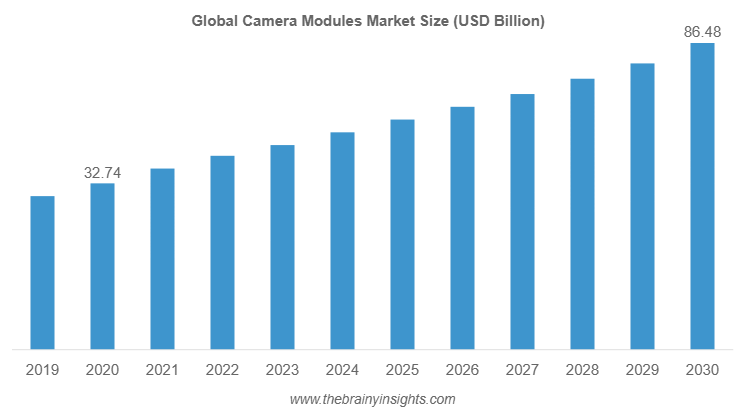
Camera Modules Market Overview
The camera modules market refers to the industry involved in the production and sales of miniature cameras embedded in various consumer electronics and industrial devices. These camera modules are widely used in smartphones, tablets, automotive systems, security devices, medical equipment, and other consumer electronics. The market is driven by the increasing demand for high-resolution imaging and video recording capabilities across multiple sectors.
The global camera modules market is projected to reach USD 86.48 billion by 2030, growing at a compound annual growth rate (CAGR) of 10.2% from 2021 to 2030.
Market Dynamics
Drivers:
- Smartphone Adoption: The rise in the adoption of smartphones and mobile devices, especially in emerging markets, has led to an increasing demand for camera modules with advanced features such as high-definition video, autofocus, and 3D imaging.
- Automotive Industry Growth: Camera modules are increasingly used in driver-assistance systems and autonomous vehicles, driving market growth in the automotive sector.
- Advancements in Technology: The development of technologies like AI, machine learning, and facial recognition is boosting the demand for advanced camera modules with high performance.
- Security and Surveillance Demand: The growing need for security and surveillance systems in both residential and commercial sectors is fueling the demand for camera modules.
Restraints:
- High Cost of Advanced Modules: The high cost associated with advanced camera modules, especially those used in high-end applications like medical imaging and automotive systems, may hinder the market growth.
- Privacy Concerns: Increasing concerns regarding privacy and data security, especially with facial recognition technology, may limit the demand for camera modules.
Opportunities:
- Emerging Markets: Rapid digitalization in emerging economies is expected to open new growth opportunities for camera module manufacturers.
- Rising Use in Healthcare and Industrial Applications: Growing use in medical imaging, industrial automation, and robotics presents new areas of application.
Regional Analysis
- North America: Dominates the market due to strong demand from the automotive, consumer electronics, and security sectors. The presence of key players like Apple, Intel, and Qualcomm in the region further boosts growth.
- Europe: A significant market for camera modules, especially driven by the automotive and healthcare industries. The presence of leading automotive companies, such as BMW and Audi, supports demand.
- Asia-Pacific: Expected to witness the highest growth due to the increasing demand for smartphones and other electronic devices, along with the presence of major manufacturers in countries like China, South Korea, and Japan.
- Latin America and Middle East & Africa: While smaller in comparison, these regions are witnessing gradual growth in demand driven by improving infrastructure and increasing security concerns.
Segmental Analysis
- By Type:
- CMOS Camera Modules: The most common type of camera module, widely used in smartphones, laptops, and consumer electronics.
- CCD Camera Modules: More expensive, but used in high-quality imaging applications such as medical imaging, scientific research, and industrial automation.
- By Application:
- Smartphones and Tablets: The largest segment due to the high demand for high-quality front and rear cameras.
- Automotive: Used in driver-assistance systems, surveillance cameras, and autonomous vehicles.
- Security and Surveillance: Used in CCTV cameras and other security applications.
- Medical: Used in imaging and diagnostic equipment.
- Other Applications: Including industrial automation, robotics, and drones.
Key Players
- Sony Corporation
- Samsung Electronics
- OmniVision Technologies
- LG Innotek
- Sharp Corporation
- STMicroelectronics
- GoPro
- Honeywell
- Canon
- Nikon
Key Trends
- Miniaturization: The ongoing trend toward miniaturizing camera modules while improving image quality and performance. This is particularly important for smartphones and wearable devices.
- AI Integration: Increasing integration of AI technology into camera modules, enabling features like facial recognition, enhanced imaging, and smart camera systems.
- 3D Imaging and AR/VR Applications: The rise of augmented and virtual reality applications is increasing the demand for 3D camera modules.
- High-Resolution Cameras: There is a growing trend towards higher megapixel cameras to deliver superior image quality, especially for mobile phones and professional-grade cameras.
Request PDF Brochure: https://www.thebrainyinsights.com/enquiry/sample-request/12642
Conclusion
The camera modules market is expected to grow significantly driven by technological advancements in mobile and automotive sectors, increasing demand for security systems, and emerging applications in industrial and healthcare sectors. While the market is challenged by high costs and privacy concerns, the rising need for advanced camera solutions presents ample opportunities for growth. As technology continues to evolve, the market will likely experience a transformation in terms of miniaturization, performance, and application diversity.
